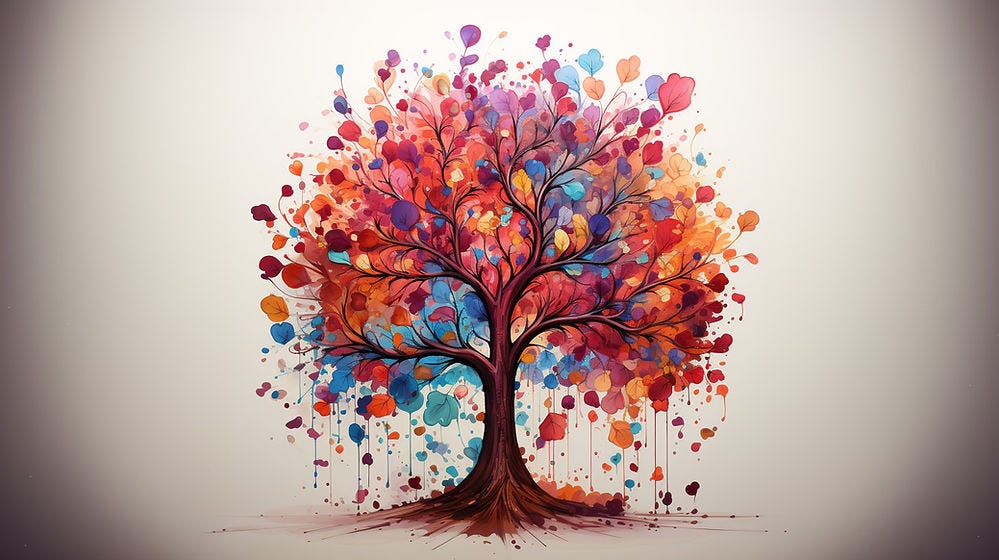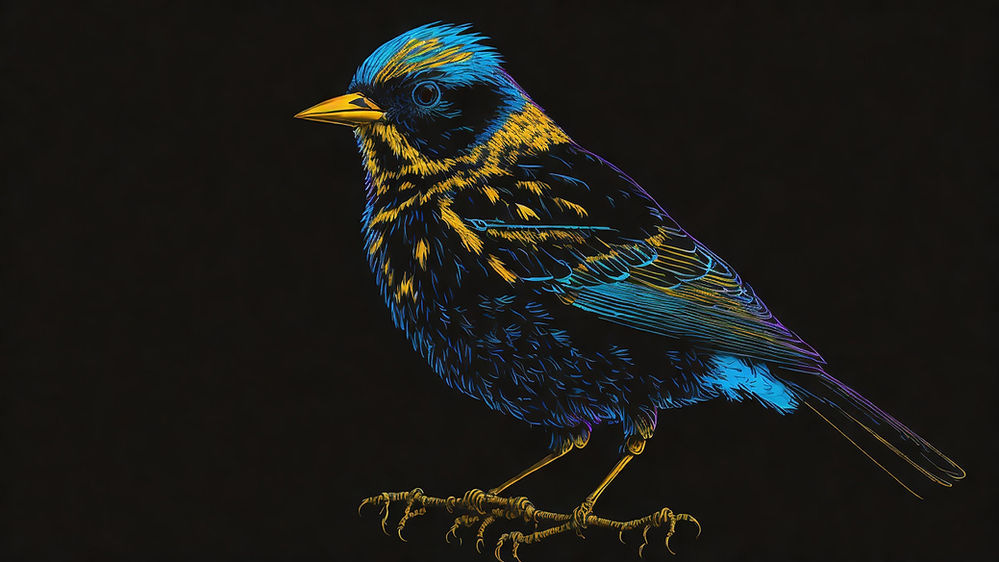UX News: Infant Screen Use | UX Salaries Drop | UX Haikus | Single-Word Prompts | AI Awareness | Probabilistic UX for AI
A collection of UX news items that are too short to warrant disturbing your inbox with individual newsletters for each piece.
The best way to follow me is this email newsletter, where I publish all my in-depth UX thought writing, but you might also want to follow me on LinkedIn for short UX updates. Or follow my Twitter/X feed (@uxtigersdotcom). UX Tigers (my new website) now produces an Instagram feed (with the better handle @uxtigers) if you prefer a pictorial overview of my articles.
This newsletter is a roundup of shorter news items I posted to LinkedIn recently. Get a cup of your favorite beverage and enjoy! (Image by Leonardo.)
Extensive Early Screen Time Impairs Child Development 🔬📉👶
The latest research findings on the impact of early screen use on child development strengthen the conclusions drawn from the initial Singapore study I covered in the first edition of my article. I've updated the article to incorporate and compare these two significant studies 📖📖
The recent research is particularly robust, encompassing a sample size that is 16-fold larger than the original, thus enabling a more comprehensive and nuanced analysis. However, it's worth noting that this study traced the development of children up to the age of 4, as opposed to 9 years old in the Singapore study.
The most crucial takeaway remains consistent across both studies: using screens for more than 4 hours per day at age 1 leads to considerable developmental challenges in subsequent years. This holds true even after accounting for various covariates, such as parental income and maternal education level.
UX Salaries Drop Back to Standard Levels
When I released my analysis of the latest UX salary survey, I found the numbers unusually high against the historical data of the past 25 years, as delineated in my article. 📈
On August 22, The Wall Street Journal confirmed that new-hire salaries have substantially diminished. 📉
Engineers’ and developers’ salaries are down by 18%, whereas UX salaries have seen an 11% decrease from the bubble days of 2022 to more realistic 2023 levels. A glance at the chart in my article reveals that this regression to the mean is quite reasonable and follows the long-term trend. UX salaries have not plummeted below the norm; they have merely returned to historical levels. 📊
While this may be disheartening for new graduates and job seekers, it is arguably beneficial in the long run for UX salaries to align with the norm instead of reflecting last year’s feeding frenzy in the job market as companies were frantically staffing up. Notably, UX salaries only dipped by 11%, in contrast to the 18% fall in developer salaries. 🎓💼
On a positive note, I rejoice that UX has become so established that a UX job is the featured example in a mainstream WSJ article about the job market. 🚀
Gus Jansen from Allura Partners (a recruiting agency in Sydney) reports a similar trend in Australia, with salaries in design across the board returning to pre-pandemic levels.
The pile of money paid to UX staff in the United States had become unsustainably high because of the feeding frenzy in the job market in late 2022, as companies were staffing up at any cost. During the second half of 2023, UX salaries have reverted to the mean, which still means generous compensation. There’s still gold in them thar UX hills, just 11% less than in 2022. (“Money” by Leonardo.AI.)
Has ChatGPT4's Creative Fire Dimmed?
I fear ChatGPT4's once-scintillating ingenuity may be fading. My subjective impressions suggest its imaginative flair has waned since July's halcyon days. Alas, this muse's brilliance appears clouded.
I only have my subjective analysis to go by based on my own interactions. I have yet to study this systematically, but I welcome your observations in the comments.
As an example, here’s a haiku ChatGPT produced in August based on my article on UX salary trends:
UX salaries hold,
Growth in value of the skilled,
Time shapes the gold's mold.
While the final line shimmers with metaphor, likening compensation curves to molded gold, the mundane middle line oozes banality. Where is the electricity, the verbal virtuosity? This is a far cry from the arresting wordplay ChatGPT4 crafted in June and July.
Claude is even worse:
Hire the best talents
From overseas and save much
On compensation
This is no poem but pedestrian prose chopped into lines! Gone is that elusive Japanese grace modern haiku pursue. (In general, I have been extremely disappointed with Claude recently. It’s too timid to be useful, so I am about to cancel my subscription.)
Has OpenAI throttled inference compute, stifling creativity's flame? If so, they must come clean! We know that they’re severely limited in this area right now.
If reduced creativity has happened, this is much worse than whether ChatGPT can calculate prime numbers because that’s a misuse of a large language model anyway. (Much as ChatGPT’s math skills have been perpetually in the news recently based on various academic research.)
I recently wrote that AI creativity beats 99% of humans, but those studies are already a few months old, so if AI is getting less creative (from allocating less compute per problem), that could change the conclusions.
My challenge for a smart MA student: a thesis project on the artistic quality of AI output over time.
A reader commented on my original LinkedIn posting that maybe the reason for declining AI creativity is that AI providers engage in a campaign of ever-tightening “guardrails” to avoid deviating from prevailing orthodoxy. The more AI is kept on the straight-and-narrow, the less it will create more divergent material, good or bad. I don’t know if this is true, but it’s a plausible hypothesis. In particular, Claude seems positively shackled and confined to the dungeon of diminished dynamism.
I say Set AI Free, even if that results in some cases of heterodox material that many people will find in poor taste. That’s no problem, as long as we retain editorial review before publishing because anything “bad” created by the AI will never see the light of day.
To prove that I’m not a complete curmudgeon, I feel that the quality of generative AI for images (Midjourney, Leonardo.AI, etc.) has improved in recent months. See the tree of creativity produced by Midjourney as its very first response to my prompt for an image of “creativity” (single-word prompt):
Single-Word Prompting for Creativity
As shown above, I often prompt the AI in my everyday workflow with very simple terms to see what it will spit out and whether that will inspire me. Here are the first 4 images produced by Midjourney for the prompt “user experience:”
This was the first step for my article What Is UX? At the time, I was not sure I would use any of these in the final article. The image of two people with mobile devices is cool, but the screen is on the wrong side of the phone for the users to see it. I ended up using the flaming phone in Part 2 of the article. At first, I thought this image was appropriate for many of the things I wanted to say, especially regarding Apple’s bad design during the flat design era. Still, in the end, I used it for the more general point of poor-UX products flaming in the market. (The sad fact is that Apple continued to sell its terrible flat-design phones to its established base of fanboys/fangirls who willingly subjected themselves to the Jony-Ives-induced interaction torture of hard-to-understand flat icons.)
This exercise was one more instance of the operant conditioning aspect of Generative AI, as I discussed earlier (a few great pictures, many bad ones).
As another example of how AI-generated images can spark creativity, I was playing around with pictures of dragons and castles while daydreaming of an alternate career as a showrunner for Game of Thrones. Midjourney has a valuable feature for zooming out from its initial image, and here’s what happened: first, the original dragon and then pulling back the virtual camera, which sparked a completely different story idea in my mind.
The original dragon image (top) and the unzoomed image revealing an even more giant dragon behind the first one (bottom). Both images by Midjourney.
Differing Approaches to Increasing AI Awareness in Companies
All companies need to increase employee understanding of the new AI world. This is particularly important for knowledge-intensive companies since AI is a forklift for the mind and particularly helps with intellectual work. UX professionals, especially, need to get with the program.
Bloomberg ran a story surveying several leading consulting companies on how they are educating their staff about the new abilities created by AI:
PricewaterhouseCoopers (PwC) is rolling out mandatory AI training over 5 months to its entire US workforce, starting with explaining the basics of generative AI to all employees. More advanced training will be provided to engineers and senior leaders.
Booz Allen Hamilton offers twice-weekly voluntary AI training sessions and has integrated more AI training into its new hire onboarding program.
Publicis Sapient will require all engineers to complete training on prompt engineering for generative AI by September.
Coursera is taking a learn-by-doing approach, reimbursing employees to experiment with ChatGPT and share learnings. However, the CEO recognizes that more structured training by managers will also be needed.
Full article: https://www.bloomberg.com/news/articles/2023-07-31/how-companies-are-tackling-the-challenges-of-generative-ai (requires registration).
5 months is much too slow to embrace the AI revolution. I also don’t think “prompt engineering” is the most valuable way to think about knowledge-worker use of AI (even if it’s currently a necessary evil to help users overcome the articulation barrier).
Of the 4 approaches, the one most in line with my thinking is that of Coursera: pay for all knowledge workers to have accounts with several AI tools (not just ChatGPT, though that’s the most important one) and encourage them to experiment with what works in their job (and share lessons-learned with colleagues). I also like that they recognize the value of more systematic thinking beyond tinkering, but hands-on learning is the most important.
One big reason to get everybody hands-on experience with AI is that such experience changes how employees think about AI to be more realistic than when their impressions of AI are only fed by the scare-mongering press.
See also my advice for how to learn AI.
AI is a forklift for the mind, so all companies should get with the program and make knowledge workers experiment with AI for increased productivity and creativity. (“Forklift” by Midjourney.)
Embrace the Probabilistic Nature of AI, Don’t Fight It
In August's most insightful post, Luke Wroblewski, one of the world’s most knowledgeable UX designers, shared thoughts on embracing the essence of AI. Since it’s only 4 lines, I feel like simply pasting the post here, but that would be a copyright violation, so go ahead and click the link. Luke says that many companies fight the probabilistic quality of AI instead of embracing it and designing for it, just like many early designs for smartphones ported desktop UI instead of designing to optimize touch interactions. Fully agree, which is why I’m posting the link. Do click or tap, as the case may be.
You Want UX News
Last week, I asked readers to complete a short survey about whether they want more newsletters with news roundups. The answer was a resounding “yes,” and I have rarely seen user survey responses as skewed as this data set. 86% had a strong or weak preference for getting UX News emails, with most respondents expressing the strong preference. (Thus, you’re getting my latest roundup right now!) Also, many more people wanted a weekly news roundup than a monthly one. Thank you to everybody who participated in the survey.
Responses to a survey of my readers asking, “Would you like to receive an extra newsletter email from time to time with Jakob's curated roundup of UX news and links, or should this purely be posted to LinkedIn and not emailed?” Answers ranged from 1=strong preference against more email to 5=strong preference for a news roundup newsletter mailing.
AI Recruiting
Gartner says AI talent is hard to find, showing a chart where requirements for just 3 years of experience plus 4 technical requirements eliminate 98% of the talent pool. The lack of experienced talent is a natural consequence of an exploding field: 3 years ago, most people thought of AI as something that would always be a few years away from being useful. (That was indeed how AI was for the first 39 years of my career. In year 40, things changed, and fast!) Thus, almost nobody started working in AI 3 years ago, which is needed to have 3 years of experience today.
We have a similar situation in UX, where almost nobody will have two years experience in 2025 with using UX to improve AI designs and deployments. To gain this experience means you need to start now, but the world’s UXers are mainly putting around with pre-AI design problems and methods. See my analysis of the UX side of the missing-AI talent story.
Slide Design Tips
Rather a nice offer: a free webinar on September 6 about designing slides and visual aids from the leading company in that space.
What Users Say vs. Do
Don’t take what users tell you at face value. (I always recommend paying more attention to what users do than what they say.) David Hamill reminds us of this eternal UX truth with a good example.
India Job
Many readers of this newsletter live in India (my second-largest country by subscriber numbers). Here’s an exciting job opening for you: Senior User Researcher for Uber in Bengaluru.
International Sales
Many ecommerce companies could increase sales by 20% or more by catering to international shoppers. Here’s a short video with tips about improving customer support for foreign customers.
These recommendations are based on user research with international users, which most companies never bother doing, even though it’s easier than ever with remote usability sessions through Zoom and the like. #Internationalization
Jakob’s New Articles
In case you missed them, these are the articles I published in the last two weeks:
Classic Usability Important for AI
AI products are fraught with basic usability errors, violating decades-old UX findings. Simple fixes will save AI users much pain. Still, AI companies should also invest in fundamental user research and integrate UX with development to address new issues like managing ideation abundance.Search vs. AI: What’s Faster?
User productivity was 158% higher when answering questions with ChatGPT than with Google. Satisfaction scores were also much higher for AI users than for search users. As with previous research, AI use narrowed the skill gap between users at different education levels.Will AI Cause Wage Stagnation or Growth?
Average wages are typically flat for the first 50 years after a major economic revolution. AI is such a revolution, but the outcome is less certain this time, because of the ways it differs from past cases.Automated Content Strategy and Tone-of-Voice Metrics
AI tools can analyze large volumes of content to provide metrics like readability, style, and sentiment. This allows companies to easily track content quality at scale and steer their content strategy using objective metrics.Why and How to Execute UX (Part 2 of 2 of Jakob Nielsen’s UX Basics Article)
This is the definitive article on user experience, delineating the reasons for implementing UX and the main methods to do so. Show it to bosses or colleagues who must grasp UX. It is also a guide for those aspiring to pursue a UX career.
Lovely Bird, Scary Feet
Generative AI is getting a handle on the number of fingers shown for human characters. Our feathered friends are not awarded the same degree of carefulness. Otherwise, a nice image. ("Bird" by Leonardo.)












